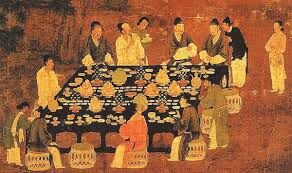“Unlock the Culinary Mastery of Chinese Cuisine: A Flavorful Journey through Regional Delights, Bold Techniques, and Timeless Traditions with a Dash of Fusion Innovation!”,2023

Table of Contents:
(“Unlock the Culinary Mastery of Chinese Cuisine: A Flavorful Journey through Regional Delights, Bold Techniques, and Timeless Traditions with a Dash of Fusion Innovation!”,2023)

1. Introduction
2. History of Chinese Cuisine
3. Regional Varieties
- 3.1 Northern Cuisine
- 3.2 Southern Cuisine
- 3.3 Eastern Cuisine
- 3.4 Western Cuisine
4. Staple Ingredients
- 4.1 Rice
- 4.2 Noodles
- 4.3 Vegetables
- 4.4 Meats
- 4.5 Seafood
5. Culinary Techniques
- 5.1 Stir-Frying
- 5.2 Steaming
- 5.3 Braising
- 5.4 Deep-Frying
- 5.5 Boiling
6. Famous Chinese Dishes
- 6.1 Peking Duck
- 6.2 Dim Sum
- 6.3 Kung Pao Chicken
- 6.4 Mapo Tofu
- 6.5 Xiaolongbao
7. Chinese Food Culture
- 7.1 Dining Etiquette
- 7.2 Traditional Chinese Banquets
- 7.3 Festive Foods
8. Fusion and Contemporary Chinese Cuisine
9. Health Benefits of Chinese Food
10.Popular Chinese Beverages
11.Conclusion
1. Introduction:
- Chinese cuisine, with its rich history and diverse regional influences, stands as one of the world’s most celebrated culinary traditions. From the sizzling streets of Beijing to the spice-laden kitchens of Sichuan, Chinese food captivates the taste buds with an array of flavors, textures, and aromatic combinations. This comprehensive guide explores the depths of Chinese gastronomy, delving into its history, regional varieties, staple ingredients, culinary techniques, famous dishes, food culture, and the evolving landscape of contemporary Chinese cuisine.
2. History of Chinese Cuisine:
- Chinese culinary heritage dates back thousands of years, evolving through dynasties and diverse geographical regions. Ancient texts, such as “Yinshan Zhengyao” from the 7th century, offer insights into early Chinese gastronomy. The Silk Road played a crucial role in introducing spices and ingredients, influencing the fusion of flavors. The imperial courts further refined the art of Chinese cooking, establishing culinary traditions that continue to influence global cuisine.
3. Regional Varieties:

- 3.1 Northern Cuisine:
- Northern Chinese cuisine, characterized by wheat-based staples like noodles and dumplings, reflects a preference for hearty, warming dishes. Peking duck, a renowned northern delicacy, showcases the region’s mastery in roasting.
- 3.2 Southern Cuisine:
- Southern Chinese cuisine, encompassing Guangdong and Fujian provinces, emphasizes freshness and sweetness. Cantonese dim sum and the use of seafood exemplify the vibrant flavors of the south.
- 3.3 Eastern Cuisine:
- Known for delicate flavors and exquisite presentation, eastern Chinese cuisine, including the iconic Shanghai dishes, balances sweetness, umami, and fragrance.
- 3.4 Western Cuisine:
- Sichuan and Hunan provinces represent the fiery and bold flavors of western Chinese cuisine. Sichuan’s use of peppercorns and Hunan’s spicy dishes showcase the region’s distinct culinary identity.
4. Staple Ingredients:(Unlock the Culinary Mastery of Chinese Cuisine: A Flavorful Journey through Regional Delights, Bold Techniques, and Timeless Traditions with a Dash of Fusion Innovation!”,2023)
- 4.1 Rice:
- As a staple food, rice plays a central role in Chinese cuisine. Whether steamed, fried, or congee, rice serves as the foundation for many dishes.
- 4.2 Noodles:
- Noodles, made from wheat or rice, are another essential component. From the simplicity of chow mein to the complexity of hand-pulled noodles, this versatile ingredient is celebrated in various forms.
- 4.3 Vegetables:
- Chinese cuisine embraces a wide array of vegetables, showcasing the importance of balance and harmony in each dish. Bok choy, Chinese broccoli, and bamboo shoots are common additions.
- 4.4 Meats:
- Pork, beef, chicken, and duck are popular meat choices. Various cuts and cooking methods contribute to the diverse meat dishes found across China.
- 4.5 Seafood:
- Given China’s extensive coastline, seafood plays a significant role. Fresh fish, shrimp, crab, and abalone are often featured in coastal cuisines.
5. Culinary Techniques:(Unlock the Culinary Mastery of Chinese Cuisine: A Flavorful Journey through Regional Delights, Bold Techniques, and Timeless Traditions with a Dash of Fusion Innovation!”,2023)

- 5.1 Stir-Frying:
- The art of stir-frying, with its quick cooking over high heat, preserves the natural flavors and textures of ingredients. This technique is fundamental to many Chinese dishes.
- 5.2 Steaming:
- Steaming is a gentle cooking method that retains nutrients and enhances natural flavors. Dim sum, such as dumplings and buns, often undergo steaming.
- 5.3 Braising:
- Braising involves slow-cooking ingredients in a flavorful liquid. This method is employed in dishes like red-braised pork belly, where the meat absorbs rich, savory flavors.
- 5.4 Deep-Frying:
- Deep-frying adds a crispy texture to various dishes. From spring rolls to sweet and sour chicken, this technique is widely used in Chinese cuisine.
- 5.5 Boiling:
- Boiling is employed in soups and hot pots, creating nourishing broths. Chinese hot pot, a communal dining experience, involves cooking raw ingredients in a shared pot of simmering broth.
6. Famous Chinese Dishes:(Unlock the Culinary Mastery of Chinese Cuisine: A Flavorful Journey through Regional Delights, Bold Techniques, and Timeless Traditions with a Dash of Fusion Innovation!”,2023)
- 6.1 Peking Duck:
- Peking duck, a symbol of Chinese culinary finesse, features crispy skin, succulent meat, and thin pancakes. The preparation involves air-drying the duck, seasoning, and roasting until perfection.
- 6.2 Dim Sum:
- Dim sum encompasses a variety of bite-sized dishes served in steamer baskets. Dumplings, buns, and rolls filled with various ingredients are staples of this Cantonese tradition.
- 6.3 Kung Pao Chicken:
- Hailing from Sichuan, Kung Pao Chicken combines tender chicken, peanuts, and chili peppers in a spicy, savory sauce. The dish exemplifies the bold flavors of Sichuan cuisine.
- 6.4 Mapo Tofu:
- A spicy and numbing dish from Sichuan, Mapo Tofu features silken tofu in a flavorful chili and bean-based sauce. Sichuan peppercorns contribute a unique tingling sensation.
- 6.5 Xiaolongbao:
- These delicate soup dumplings from Shanghai are filled with savory broth and pork, creating a burst of flavor with each bite. The thin, delicate skin showcases the craftsmanship involved in their preparation.
7. Chinese Food Culture:(Unlock the Culinary Mastery of Chinese Cuisine: A Flavorful Journey through Regional Delights, Bold Techniques, and Timeless Traditions with a Dash of Fusion Innovation!”,2023)
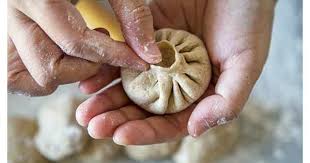
- 7.1 Dining Etiquette:
- Chinese dining etiquette places emphasis on communal dining, sharing dishes, and using chopsticks. Respect for elders and hosts is a key aspect of the dining experience.
- 7.2 Traditional Chinese Banquets:
- Elaborate banquets, often associated with celebrations and important events, showcase a wide array of dishes. The order of serving and the symbolism behind certain foods are carefully considered.
- 7.3 Festive Foods:
- Chinese festivals bring forth a unique array of traditional dishes. During the Lunar New Year, for example, symbolic foods like fish, dumplings, and longevity noodles are enjoyed for their auspicious meanings.
8. Fusion and Contemporary Chinese Cuisine:(Unlock the Culinary Mastery of Chinese Cuisine: A Flavorful Journey through Regional Delights, Bold Techniques, and Timeless Traditions with a Dash of Fusion Innovation!”,2023)
- As global tastes evolve, Chinese cuisine has seen a surge in fusion and contemporary interpretations. Chefs around the world experiment with traditional flavors, creating innovative dishes that appeal to a diverse audience.
9. Health Benefits of Chinese Food:(Unlock the Culinary Mastery of Chinese Cuisine: A Flavorful Journey through Regional Delights, Bold Techniques, and Timeless Traditions with a Dash of Fusion Innovation!”,2023)
- Chinese cuisine, with its focus on balance and variety, offers numerous health benefits. From the antioxidant-rich green tea to the anti-inflammatory properties of ginger and garlic, Chinese ingredients contribute to overall well-being.
10. Popular Chinese Beverages:(Unlock the Culinary Mastery of Chinese Cuisine: A Flavorful Journey through Regional Delights, Bold Techniques, and Timeless Traditions with a Dash of Fusion Innovation!”,2023)
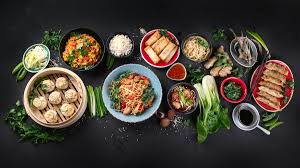
- In addition to its diverse array of dishes, Chinese beverages hold a special place in the culinary landscape. From traditional teas like green tea and oolong to modern bubble tea, the drink choices complement the richness of Chinese flavors.
Regional Varieties:
Northern Cuisine
- Northern Chinese cuisine, influenced by the colder climate, leans towards heartier, warming dishes. Wheat-based staples like noodles and dumplings take center stage. Peking duck, a delicacy hailing from Beijing, exemplifies the northern mastery of roasting. The dish is a testament to the artistry involved in achieving crispy skin, succulent meat, and thin, delicate pancakes.
Southern Cuisine:
- In contrast, southern Chinese cuisine, particularly in Guangdong and Fujian provinces, is characterized by freshness and sweetness. Cantonese dim sum, a quintessential part of southern culinary tradition, offers an array of bite-sized delights served in steamer baskets. Seafood, reflecting the region’s extensive coastline, is a prominent feature, with dishes like sweet and sour fish showcasing the vibrant flavors of the south.
Eastern Cuisine: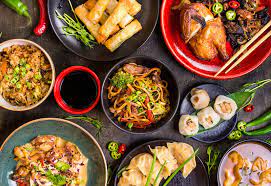
- The eastern part of China, including Shanghai and Zhejiang, is known for its delicate flavors and exquisite presentation. Shanghai dishes, in particular, balance sweetness, umami, and fragrance, creating a culinary experience that is both refined and memorable. The emphasis on fresh, seasonal ingredients is evident in dishes like “Lion’s Head” meatballs, where pork is shaped into large, round meatballs symbolizing strength and unity.
Western Cuisine:
- Western Chinese cuisine, represented by Sichuan and Hunan provinces, introduces bold and fiery flavors to the culinary landscape. Sichuan cuisine, famous for its use of peppercorns, creates a unique numbing and spicy sensation in dishes like Mapo Tofu. Hunan cuisine, on the other hand, relies heavily on chili peppers, resulting in dishes that are robust and intensely flavored. Both regions showcase the diversity within Chinese cuisine, offering a symphony of tastes that cater to different palates.
Staple Ingredients:
Rice:
Rice, a staple in Chinese cuisine, takes on various forms and plays a central role in the majority of meals. Whether it’s steamed white rice served alongside flavorful stir-fries or congee for breakfast, rice is the foundation upon which many Chinese dishes are built.
Noodles:
Noodles, made from wheat or rice flour, come in countless varieties and are celebrated in various forms. From the simplicity of chow mein to the complexity of hand-pulled noodles, this versatile ingredient showcases the artistry and skill of Chinese chefs.
Vegetables:
Chinese cuisine places a strong emphasis on a balanced and harmonious combination of flavors. Vegetables like bok choy, Chinese broccoli, and bamboo shoots are not just side dishes but integral components of many main courses, contributing freshness and texture to the overall meal.
Meats:
A variety of meats are used in Chinese cuisine, with pork, beef, chicken, and duck being the most common. Different cuts and cooking methods, from slow braising to quick stir-frying, create a diverse array of meat dishes that cater to different tastes and preferences.
Seafood:
Given China’s extensive coastline, seafood is a natural and integral part of the cuisine. Fresh fish, shrimp, crab, and abalone are often featured in coastal cuisines, adding a luxurious and flavorful element to the dining experience.
Culinary Techniques:
Stir-Frying:
Stir-frying, a hallmark of Chinese cooking, involves quick cooking over high heat. This technique preserves the natural flavors and textures of ingredients, creating dishes that are vibrant, crisp, and full of flavor. The wok, a versatile cooking vessel, is the tool of choice for stir-frying.
Steaming:
Steaming is a gentle cooking method that retains the nutrients and natural flavors of ingredients. Dim sum, a popular Cantonese tradition, often involves delicate dumplings and buns that are lovingly steamed to perfection.
Braising:
Braising is a slow-cooking technique that involves cooking ingredients in a flavorful liquid. Red-braised pork belly, a classic Chinese dish, showcases the depth of flavors that can be achieved through this method.
Deep-Frying:
Deep-frying adds a crispy texture to various dishes, from spring rolls to sweet and sour chicken. This technique, when executed skillfully, imparts a delightful crunch while retaining the moisture and flavor of the ingredients.
Boiling:
Boiling is commonly used in Chinese soups and hot pots, creating nourishing broths that form the basis of many meals. Chinese hot pot, a communal dining experience, involves cooking raw ingredients in a shared pot of simmering broth, enhancing the social aspect of the meal.
Famous Chinese Dishes:
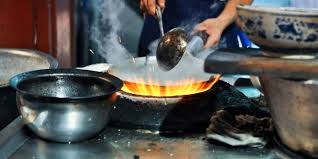
Peking Duck:
Peking duck, a symbol of Chinese culinary finesse, goes beyond its delectable taste. The preparation involves air-drying the duck, seasoning it, and then roasting until the skin achieves a crispy perfection. Served with thin pancakes, hoisin sauce, and sliced scallions, Peking duck is a culinary masterpiece that has gained international acclaim.
Dim Sum:
Dim sum, a beloved Cantonese tradition, encompasses a wide variety of bite-sized dishes. From dumplings to buns, these small but flavorful creations are often enjoyed during leisurely brunches or family gatherings. The art of making dim sum is intricate, requiring skill and precision to achieve the perfect balance of flavors and textures.
Kung Pao Chicken:
Originating from the Sichuan province, Kung Pao Chicken is a dish that exemplifies the bold and spicy flavors of the region. The combination of tender chicken, peanuts, and chili peppers in a savory sauce creates a symphony of tastes that tingles the palate and leaves a lasting impression.
Mapo Tofu:
Hailing from the fiery kitchens of Sichuan, Mapo Tofu is a spicy and numbing dish that has gained popularity worldwide. Silken tofu is bathed in a flavorful chili and bean-based sauce, with Sichuan peppercorns providing a unique tingling sensation that adds depth to the dish.
Xiaolongbao:
Xiaolongbao, delicate soup dumplings from Shanghai, are a testament to the craftsmanship of Chinese chefs. Filled with savory broth and pork, each bite releases a burst of flavor. The thin, translucent skin of the dumpling is a reflection of the meticulous care taken in their preparation.
Chinese Food Culture: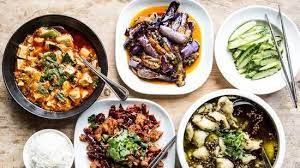
Dining Etiquette:
Chinese dining etiquette places great importance on communal dining, symbolizing unity and togetherness. Sharing dishes, using chopsticks, and showing respect to elders and hosts are fundamental aspects of the dining experience. The act of sharing food is seen as an expression of care and generosity.
Traditional Chinese Banquets:
Elaborate banquets are an integral part of Chinese culture, often associated with celebrations, weddings, and important events. The order in which dishes are served and the symbolism behind certain foods are carefully considered. These banquets showcase the diversity and richness of Chinese cuisine.
Festive Foods:
Chinese festivals bring forth a unique array of traditional foods, each with its own symbolic significance. During the Lunar New Year, for example, fish symbolizes abundance and prosperity, while dumplings represent wealth. Longevity noodles are often enjoyed during birthdays, symbolizing a wish for a long and healthy life.
Fusion and Contemporary Chinese Cuisine:
As global tastes evolve and culinary boundaries blur, Chinese cuisine has experienced a surge in fusion and contemporary interpretations. Chefs around the world are experimenting with traditional flavors, creating innovative dishes that appeal to a diverse and international audience. This fusion of culinary traditions is contributing to the continued evolution and globalization of Chinese cuisine.
Health Benefits of Chinese Food:
Chinese cuisine, with its emphasis on balance, variety, and the use of fresh ingredients, offers numerous health benefits. Green tea, a staple in Chinese culture, is rich in antioxidants and is known for its potential health-promoting properties. Ginger and garlic, commonly used in Chinese cooking, have anti-inflammatory and immune-boosting properties. The inclusion of a wide variety of vegetables further contributes to the nutritional value of Chinese meals.
Popular Chinese Beverages:
In addition to its diverse array of dishes, Chinese beverages hold a special place in the culinary landscape. Traditional teas like green tea, oolong, and pu-erh are not only enjoyed for their unique flavors but also for their potential health benefits. Modern creations like bubble tea, with its tapioca pearls and flavored teas, have gained international popularity, showcasing the adaptability of Chinese beverage traditions.
11. Conclusion:”(Unlock the Culinary Mastery of Chinese Cuisine: A Flavorful Journey through Regional Delights, Bold Techniques, and Timeless Traditions with a Dash of Fusion Innovation!”,2023)
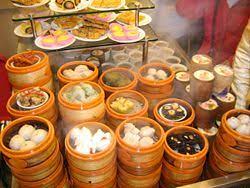
- Chinese cuisine, with its deep-rooted history, regional diversity, and culinary artistry, continues to captivate food enthusiasts worldwide. From the bustling street markets to fine-dining establishments, the essence of Chinese food lies in its ability to balance flavors, celebrate tradition, and embrace innovation. As we savor the symphony of tastes and aromas that Chinese cuisine offers, we embark on a culinary journey that transcends borders and unites cultures through the universal language of food.
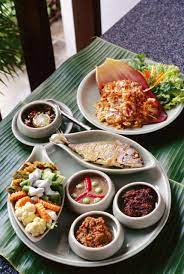 Chinese cuisine is a culinary journey that spans millennia, encompassing a rich tapestry of regional varieties, staple ingredients, culinary techniques, famous dishes, and cultural nuances. From the imperial courts of ancient China to the bustling street markets of modern cities, Chinese food has evolved and adapted, yet its essence remains deeply rooted in tradition and a profound understanding of the balance of flavors. As we explore the depths of Chinese gastronomy, we discover not only a world of taste but a cultural heritage that continues to influence and inspire culinary enthusiasts around the globe. The universal appeal of Chinese cuisine lies in its ability to transcend borders, bringing people together through the joy of shared meals and the celebration of the diverse and exquisite flavors that define this extraordinary culinary tradition.
Chinese cuisine is a culinary journey that spans millennia, encompassing a rich tapestry of regional varieties, staple ingredients, culinary techniques, famous dishes, and cultural nuances. From the imperial courts of ancient China to the bustling street markets of modern cities, Chinese food has evolved and adapted, yet its essence remains deeply rooted in tradition and a profound understanding of the balance of flavors. As we explore the depths of Chinese gastronomy, we discover not only a world of taste but a cultural heritage that continues to influence and inspire culinary enthusiasts around the globe. The universal appeal of Chinese cuisine lies in its ability to transcend borders, bringing people together through the joy of shared meals and the celebration of the diverse and exquisite flavors that define this extraordinary culinary tradition.

